How to Prepare to Lose Your Home in a Climate Disaster
There's more to prepping than canned beans and bottled water.

Unless you’ve been living under a rock (most of us aren’t that smart), you’ve probably become aware that climate disasters can happen anywhere and at almost any time.
Yes, that means it could happen tomorrow. To you.
So, you should be as prepared as you can, and particularly prepared for the unthinkable — losing your home.
There are a lot of ways to “prepare”, from building a hermetically sealed underground fallout shelter rated for 2.5 megatons to moving to a solar powered cabin in the Canadian tundra.
I’m not talking about any of that, since that’s not realistic for the vast majority of us. I’m talking about what you can do where you are right now.
Caveat: I live in a house, so some of this might not apply if you live in an apartment.
Although my wife and I were more prepared than most (we had go bags, etc.), I learned a lot from losing my home in the 2018 Camp Fire. So, I’m going to share a bit of what I learned with you.
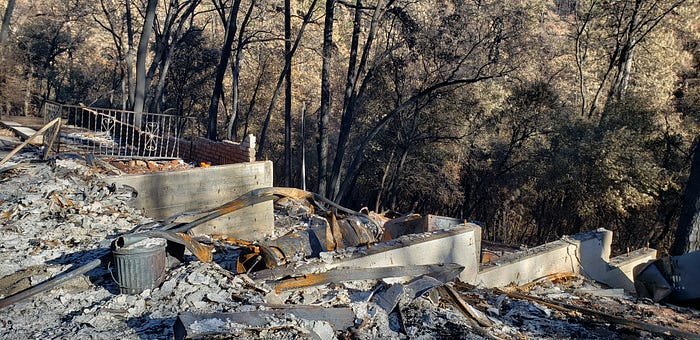
This list isn’t anywhere near exhaustive, and a lot of it has become fairly common knowledge (fortunately!), but let’s go over a few things that I’ve learned from my experience and the experiences of my fellow climate disaster survivors.
Understand Your Threats
Every place has different climate threats. Many places have multiple. Learn them, and learn what you can do to prepare your home for them and/or mitigate them. It could easily mean the difference between having a home to go back to after a climate disaster or not.
In our case, our two main threats where we are now are extreme rainfall and wildfires. We’re out of any floodplain, so that’s good. But in extreme cases, there could be runoff that pools on the upslope side of our house. So, we put in a French drain to enhance drainage. And one of the first things I did when we moved here was clear and trim vegetation near our house. I removed all shrubs within six feet of the house and trimmed up all the shrubs and trees within 50 feet to break the fuel ladder.
I could go on forever about this, but there’s plenty of stuff online about hardening your home against storms and fires, so I recommend you look there.
Know Your Escape Routes
In an emergency, your brain may turn to mush, and you might forget everything you know. So, you need to have your escape routes down cold. Not just the route you use everyday to and from work: every route. Practice them over and over, because you never know which route may be flooded, or blocked by downed trees or wildfire.
And, of course, most people will try to evacuate by the roads they typically use, so knowing alternate routes can literally save your life. It probably saved mine.
One important thing to know about emergency evacuations is that there is not a single road on the planet designed to handle a mass evacuation. Roads will back up very, very quickly. Traffic will come to a standstill. It just will.
It can take hours to travel a few miles during an evacuation, so you need to keep your gas tank pretty full. I’d always been a “refill at a quarter tank” guy — and I was lucky that I had over a half a tank when the fire happened — but now I refuel at half a tank.
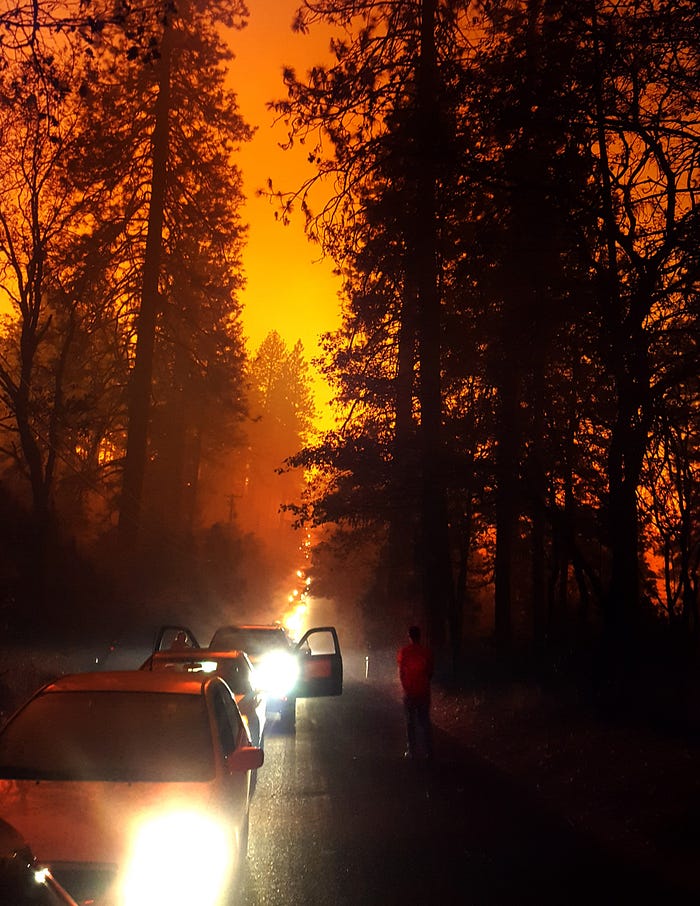
But the main thing in any evacuation is to LEAVE EARLY. Don’t be some idiot who thinks he’s going to ride it out, then realizes his mistake, leaves too late, and then burns alive (male pronouns used for fairly obvious reasons).
As soon as you detect a threat, get your pets and go bags and leave. Find a hotel room before they are all full and wait it out. The worst thing that happens is you spend a few nights in a Holiday Inn Express. OK, that’s actually pretty bad, but still.
Even though I left fairly early (9AM), it took me 4 hours to drive 10 miles, I was stuck in the flames twice, had severe PTSD as a result of the experience, and the closest hotel we could find was an hour away.
It just isn’t worth it. Be the first to leave.
In addition to escape routes, you need a meeting place in case you get separated. One of the “funny” things about the Camp Fire was that nearly everyone in Paradise had a meeting place… and it was the Walmart in Chico, about 10 miles away.
Hundreds of people set up camp in the Walmart parking lot and waited — sometimes for days — for family members. Some ended up there for weeks until they were forced out, with, of course, nowhere to go.

Emergency Notifications
The only reason our cat didn’t die in the Camp Fire was because I got a push notification on my phone from the local TV news station that simply said “All of Paradise Being Evacuated”. I left work immediately, drove into the fire, and was — barely — able to save our sweet Kitty.
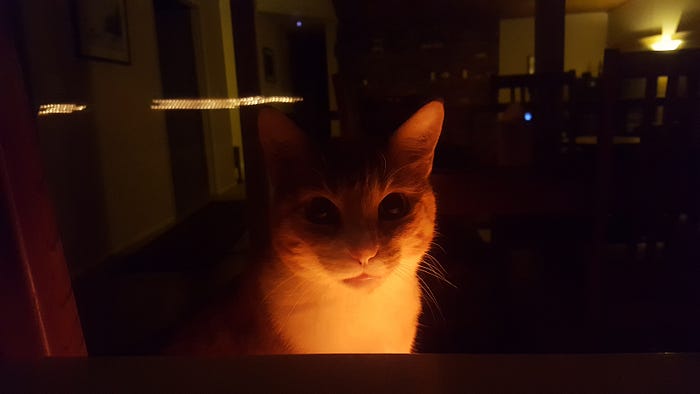
Emergency notifications can save lives. You should sign up for everything you can across as many channels as you can: weather alerts, local news alerts, Smart 911 or CodeRED or whatever local authorities use in your area, Twitter (less useful than it used to be), etc.
We have a weather radio (actually two) in our home, and it has definitely provided us with vital warnings. There’s literally no reason you should not have one.
The biggest problem with emergency notifications in the US is that there isn’t one integrated system. In Paradise, they used CodeRED, which was an opt-in system that — not to put too fine a point on it — didn’t work for shit during the fire. Neither my wife or I ever got any notifications through CodeRED. Only 16% of Paradise residents did.
So our “system” is crap, but it’s better than nothing. We try to sign up for every notification channel we can. You should too.
Insurance
I really, really, really hate to say this, because you may know just exactly how much I hate insurance companies, but (cough)… you need (choke)… to have (gag)… insurance.
There. I said it. I didn’t want to, but sadly it’s true.
Yes, our insurance company ripped us off, but in the end we did get enough to pay off our “toxic ash pile” and to relocate. Rebuild, no. But we do have a home... 3000 miles from our real home, but a home, with a roof and everything.
Without insurance, you’ll never even have a chance to recover. Nobody really does a good job of tracking what happens to climate victims, but homelessness in Chico (the nearest city) more than doubled after the Camp Fire. I guarantee that the vast majority of those people had no insurance or too little insurance.
I know insurance is a rip off. I know that you’re not “in good hands”. I know your insurer is not “on your side”. I know your insurer is not “a good neighbor”. And I know that insurance will not make you whole.
But without it, you’ll have nothing. You’ll lose everything except your mortgage payment.
You’ll be homeless with no money to escape homelessness. You’ll be paying $200, $300, $500 per night for hotel rooms out of your own pocket. How long can you afford do that?
I knew people who were still living in hotels (paid for by their insurance) over a year after the 2017 Tubbs fire. At $250/night x 365 nights… that’s over $90,000. You got that kinda cash?? Even if you’re paying $5,000/year for insurance, that’s 18 years of premiums, just covering hotel rooms.
The only thing worse than having insurance is not having insurance.
FEMA won’t help you. Only 1% of people get the maximum amount of FEMA aid… which is only $41,000. Good luck rebuilding on that. And it will take months and months to get it.
Even if you are a renter, you need insurance. It’s amazing how much stuff we accrue over time and how much it costs to replace.
I worked with a woman who rented, had no insurance, and lost everything. She had no way to even buy a second pair of underwear without spending her own money. When you have to replace every stitch of clothes you had just to be able to go to work on Monday, the cost adds up extremely fast.
And make sure you understand your insurance, what it covers and what it doesn’t. If you are in a flood-prone area, your homeowners insurance almost certainly does not cover flood damage. And you do not want to get into a fight with your insurer over what was flood damage and what was wind damage after a hurricane or derecho. You’re going to lose that battle.
Lastly, keep your coverage up-to-date. Real estate values have gone up dramatically in the past few years, and so has the value of your house — and the cost to replace it. Make sure you have at least Coverage A at 150% of the estimated value of your home (any of the major real estate sites will give you an up-to-date estimate).
Contents Inventory
This is something you should do if you have insurance, and even if you don’t.
When you lose everything in a climate disaster (especially a wildfire where nothing recognizable may be left), your insurance company may require you to provide a complete list of all the contents of your home — down to the toothpick.
I know that sounds literally insane, but it literally happened to us.
Now, your insurer might not require a full listing of contents. In my experience there is a lot randomness to whether or not you’ll be required to provide this. Variables include insurance company policy, your specific policy’s terms, the size of the disaster (insurers tend to tighten the screws when they see a lot of money headed out the door), and even your individual adjuster (who rotate regularly and have radically different interpretations of your policy).
But if they do, you need to be ready.

So here’s what I do:
Every New Years Day I go through the entire house (and garage!) and take pictures of EVERYTHING.
I open every drawer, every cabinet, every closet, the fridge, etc., etc. and take a picture. I take pictures of every room; the furniture, rugs, stuff on the walls. EVERYTHING.
And then I make sure the photos are stored in the cloud (my phone is set to automatically upload every picture I take to both Dropbox and Google Photos). Those photos are going to do you no good stored on a computer that is washed away in a flood.
Why New Years Day? First of all, it’s an easy day to remember. It’s not some random day you’ll forget. Second, it’s a holiday. You’re going to be at home, either nursing a hangover or watching football games. Maybe both. And lastly, you just got a whole bunch of useless new crap for Christmas. What better time to add it to your inventory?
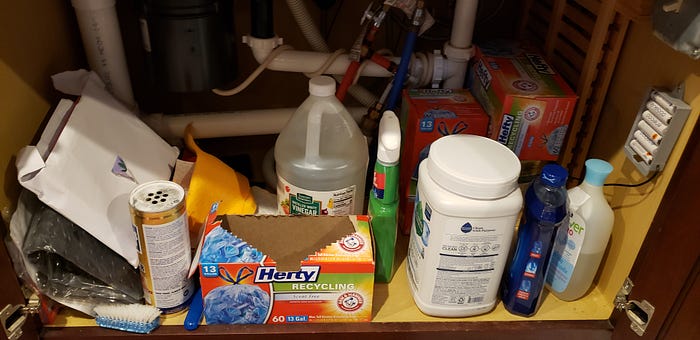
Even if you don’t have insurance (you’re gonna regret that), you should make an inventory. You might end up as part of a lawsuit or settlement where you’ll be required to substantiate your claim with evidence.
It’s become a New Years Day tradition for us.
Go Bags
You at least have a go bag, right? Right?? C’mon.
You can look up go bags online, so I won’t waste a lot of time on what to put them. Ours have several changes of clothes, USB cords, batteries to charge our phones, and medications. Not much else.
When the Camp Fire happened, we had go bags and they were right by the front door. When I got home to rescue the cat, I was able to grab them and, well, go. Awesome!
But there was a downside. I had packed the bags in the spring. They were full of shorts and short-sleeved shirts. It was now November and cold. A week after the fire, it started to rain and rained for weeks. Not as awesome as I had hoped.
So here’s what I do now:
Every May 1 and every November 1, I go through the go bags and update everything. I replace the meds with fresh pills. I charge the batteries. And I swap out the clothes for seasonally appropriate wear.
Have pets? They need a go bag as well. We have two cats. We keep cat carriers close to the front door and have a go bag for them right next to ours. It mostly contains wet and dry cat food, a few toys, bowls and the like. I update it every six months as well, cycling in new food so that it’s never stale or out of date.
We also have an emergency kit in the car. It has a hand crank radio, blankets, water, batteries, multi-tool, flashlights, and sundry other gadgets. I charge the batteries and cycle perishables every May 1 and November 1.
Oh, and rookie mistake on go bags: putting shitty ill-fitting clothes that you’d never wear in your go bag. Well, guess what you’re wearing in an emergency? That pair of jeans with the hole in the butt. That shirt that’s a size too small. Get some decent clothes that fit at Goodwill or whatever.
Documentation
This was a huge, huge problem for many Camp Fire victims. Many people not only lost all of their possessions, but everything from their driver’s license to their insurance policy to the deed to their home.
Paper burns surprisingly well. Who knew??
But seriously, some people didn’t even remember who their insurer was, and had no way to find out. At the Disaster Recovery Center set up in Chico after the fire, the line of people to replace their IDs and Social Security cards stretched out the door.
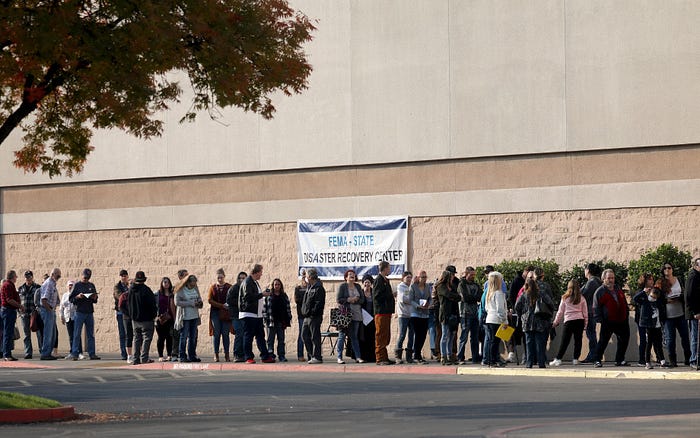
And fire might be the worst, but paper doesn’t do well being turned into a moldy blob by floods or being blown into the next county by a hurricane.
So, don’t ever keep irreplaceable documents in your home if there is any other alternative (especially your deed and insurance policy!). We have a safe deposit box for important hard copies (which isn’t cheap, and not available to many), but mostly we keep copies of EVERYTHING in the cloud.
Our insurance policy. Our deed. Our trust. Our wills. Copies of our driver’s licenses, passports, and Social Security cards. Tax returns. Marriage certificate (needed that several times). Anything that we might need in an emergency, there’s a copy in the cloud.
If you aren’t storing this stuff in a secure cloud location, accessible from your phone, then you are definitely doing it wrong.
Oh, one last point about our safe deposit box: we kept the key in a very safe place. Yeah, you guessed it… in the house. So they had to drill out our lock so we could get into it. Would have been a couple hundred dollars, but they waived the fee since, you know, we had nothing. Now, the key is on my key chain.
“Document safes!”, you proudly say. Document safes are literally worthless. We had one in the corner of our garage. When we finally got it opened (it was warped by the heat), it was completely empty. Literally everything inside had vaporized.
Most document safes are rated for 1700° F for 1 hour. My wife had two jade bracelets that melted in the fire. Jade melts at about 2300° F. And of course, houses burn for hours and hours and hours. Like I said, document safes are worthless. Don’t waste your money.
Instead, spend it on secure cloud storage.
Other Stuff
I’ve focused here mostly on preparing to lose your home to a climate disaster, but there are a thousand other things to do to prepare for circumstances that don’t require an evacuation and don’t destroy your home. Over time, I may dig into some of those, but again, there are plenty of resources out there.
Read more of Tony Dunn's work here.



